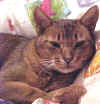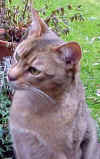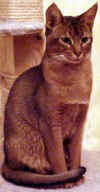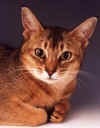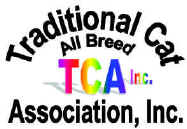
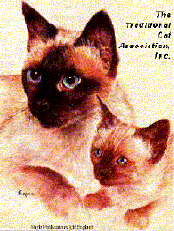 The
Traditional Cat Association,
Inc.©1987®TM
Official Website
The
Traditional Cat Association,
Inc.©1987®TM
Official Website
Founded 1987, by Diana L.
Fineran
|
" Home of the Traditional Cat"© |
|
Our Motto: To Preserve,
Protect, Perpetuate, and Promote Traditional Cats.© |
|
|
|||||||||||||
|
|
|
|
Photos Courtesy of |
The TRADITIONAL ABYSSINIAN (A) (c)
By Diana Fineran, Copyright June 8, 2000
What is the HISTORY of the TRADITIONAL ABYSSINIAN?
It is the body style and agouti coat pattern that distinguishes the Abyssinian as being the breed most resembling the cats worshipped by the ancient Egyptians. Some mention is inferred that it descends from a naturally occurring breed of cat found in the area of Ancient Abysinia (Ethiopia and Northern Africa today). This theory then asserts the Abyssinian was the cat that Pharaohs and Egyptian Royalty honored, revered, worshipped and exclusively owned, making the Abyssinian a companion of Egyptian gods some 4000 years ago. Hieroglyphs and mummified remains of similar bone structure and coat color support this idea.
Another version tries to say that the ancient line died out and today's Abyssinian resulted from hybridization to recreate the royal cat.
|
Courtesy of Mary Rose Douglas Click on to Enlarge |
Genetic Research indicates they descended from a breed found in Southeast Asia and the coast of the Indian Ocean. Therefore, they are not a created breed, but a natural breed. They resemble the African Wildcat (Felis silvestris lybica), originally widespread in Africa, Europe and Western Asia and thought to be the progenitor of all domestic cats. The African Wildcat has been identified as one of the species mummified by the Egyptians during the time of the cat cult in that country. However, their true origins are lost in the obscurity of unrecorded history.
 DD  Lad |
Courtesy of Mary Rose Douglas Click on to Enlarge
|
The skin of a small, ticked cat, considered to be the earliest identifiable Abyssinian is displayed in Holland's Leiden Zoological Museum. Around 1834, the museum purchased the skin, which looks very much like the modern ruddy Abyssinian, from a supplier of wildcat exhibits. The museum founder labeled the exhibit, "Patrie" a domestic cat of India. It may have been transported to England by merchants who had stopped in Calcutta, a major Indian Ocean port. According to Abyssinian breeder, Tord Svenson, approximately 37 percent of the cats in Calcutta today are Abyssinian in type. No Abyssinian types can be found in Egypt or Ethiopia today.
The year 1868 is distinguished as being the time of the first reliable introduction to the world of the Abyssinian, when a military expedition led by Lord Robert Napier returned to Great Britain from Abyssinia with the first cat of the breed. She was named Zula, after the port where the advance party had landed. Owned by Mrs. Captain Barrett-Lennard, she was fed on the way home on raw beef and was very wild for a long time. She eventually became very fond of her mistress, but had many eccentricities.
Zula had the unusual coloring of a ticked, ruddy coat, so attempts were made to re-create her through cross breeding with carefully selected native British cats. It is thought silver and brown tabbies were crossed with British ticked "bunny" cats (so named because the resembled a native rabbit in that region). This caused undesirable colors in the early days, as indiscriminate breeding produced silver coloration instead of ruddy. The inevitable confusion over what was the correct body type, bone structure and color resulted in the loss of the original Abyssinian type. The Aby was one of the breeds shown at the first cat show held in London's Crystal Palace in 1871. This show was put on by Harrison Weir, considered to be the "father' of the cat fancy. The Abyssinian female placed third out of approximately 160 entries. In 1882 the Abyssinian was accepted in Great Britain as a separate breed. The foremost judges of that time, Harrison Weir and Louis Wain, expressed doubts and suggested the description "Abyssinian type" be connected with the breed. Simply stated they said it could be possible for "Abyssinian type" kittens to result from chance matings between ordinary tabby cats, so the Abyssinian could not be considered a separate breed.
Early show Abyssinians in England were Sedgemere Bottle and Sedgemere Peaty. Little Bunny Teedle Tit was first in the Abyssinian class at the 1902 Crystal palace cat show. "Though", Francis Simpson states in her 1902 book, "In color she was not the best penned." She continues, "In the 1902 Crystal Palace Show there were no fewer than eleven Abyssinians penned-a record number!"
Years of arguments went on until the beginning of this century when the name Abyssinian was dropped in favor of the names, "Ticked", "British Ticks" and "Bunny Cats". Their numbers increased very slowly until the 1914-1918 World War II decimated the breed, forcing British breeders to start over. Than in 1929 the Abyssinian Cat Club was begun in England and a Breed Standard was written. Mrs. Gordon Stables was the first President of that club. It was in his book "Cats, Their Points and Characteristics, written by Mr. Gordon Stables, that the Abyssinian was first mentioned in print.
In 1909 their American story began with the importation from England by Miss Jane Cathcart of Oradell, New Jersey of Champions Aluminium and Salt. Both were thought to be "Silver" Abyssinians. Years passed by. Then in 1934 Mrs. Gardner Fiske of Boston imported from England Woodruffe Ena and Woodruffe Anthony. Both were bred by Major Sidney Woodiwiss. Ena was sold to Mary E. Hantzmon of Washington, D.C., who mated here in 1937 to her newly imported male, Ras Seyem, who was also bred by Major Woodiwiss. This mating began the real establishment of the breed in the U.S.
Mention must be made of the seven pound female Abyssinian who was shown at a cat shoe in New York in 1935. Ena had a ruddy brown undercoat ticked with dark brown and a dark stripe down the spine. Nothing is mentioned of her winnings. All that is said about her is that she was friendly.
On June 11, 1936, Carl Van Vechten made this presentation, "There should be some mention of the strange, seven pound Abyssinian cat who turned up at a cat show in New York in 1935. Ena was described as wearing a ruddy brown undercoat ticked with dark brown and a dark stripe down the spine. The head long and point4ed, the ears standing straight up, and the eyes, which now seemed yellow and now green, brilliant. Ena was friendly."
Further suggesting the authenticity of the Abyssinian's historic background connected to Egypt is documentation presented in the book, "Journey From the Blue Nile". It is an authoritative history of the Abyssinian which mentions in about 1960 a native Ethiopian cat, matching the Abyssinian Standard to a considerable degree, was brought from Addis Ababa by an American family.
Some kittens are born with very dark coats, with dark marks on their stomachs and bars on their front legs. Some have a neck lace slightly darker in color than the rest of the coat. All this coloring and markings disappear in adulthood when ticking changes to the rich ruddy color. The ticking starts to show when the kitten is about one month of age.
The original color in the breed was "Ruddy". However, the "Red" Abyssinian is suggested to have appeared in a litter of Abyssinians in 1880, although nothing else is known of the breeding. The "Red" gene is recessive, meaning that it must be present in both the Sire and queen in order for a "Red" kitten to be produced. A ruddy queen may carry the red gene, but may never produce a red kitten because she was not mated to a male carrying red. If a ruddy male carries the red gene, the female will produce both red and ruddy kittens in the litter. Only by mating red to red can a litter of entirely red kittens be produced. It was through the efforts of the British breeder, Mrs. Dorothy Winsor, patiently breeding red to red, that the new color gradually became known. In 1959 she purchased a red female, Merkland Yilma, from Lady Liverpool. Later a second female, Merkland Sheba, entered her cattery. Then a red male, Taishun Khepha was bought from Mrs. E. Menezes. Together these cats formed the basis of Mrs. Dorothy Winsor's cattery. In 1963 the Red Abyssinian was officially recognized in England. Grace Pond raised the very first Red British Champion, CH. Bernina Heidi. In the U.S. the Red Abyssinian was recognized in the same year, 1963. The first Champion and All-American Red Abyssinian (1964) was Du-Ru-Al's Sorrel Sultan, owned by Alma Cowell of Detroit Michigan.
In the 1990 issue of "Incats" Tord Svenson reports of his importation of wild Abyssinians from the jungles of Singapore, "These cats exhibit the marvelously friendly, outgoing personalities that American Abys are deservedly famous for, and the jungle Abys do have the wild markings, including bars on the legs and neck that are characteristic of the natural gene pool."
Comparisons have been made between the coat of the Abyssinian and the Mountain Lion or Cougar, who's, coloration allows it to blend into its surroundings virtually unseen. At times the Abyssinian has been described as a "miniature cougar."
In England the breed was out crossed to Russian blues to save the breed. This introduced the Blue coloration.
"It seems very clear that the original Abys, wherever they came from, were cross bred in England to keep the breed from becoming extinct. British bunny cats (also called British Ticks) were used. Silver Abys existed in England in the late 1800's, even though the color is not widely accepted today. In 1882 Harrison Weir mentions the silvers as a "new variety". After the world wars, it's almost certain that cross breeding occurred again, although I can't find definite info on when the blues and fawns began appearing. "Raby Chuffa of Selene", an outstanding male Abyssinian who came to the U.S. from Britain in 1953 and who appears on the pedigrees of many American Abyssinians, if you go back far enough, was not a 'pure" Aby. Raby Chuffa's pedigree can be traced to Roverdale Purrkins, an English Abyssinian female whose dam, Mrs. Mews, was of unknown ancestry. Mrs. Mews later produced two kittens: Roverdale Purrkins, who Robertson registered as an Abyssinian, and a black unregistered male. It seems clear that the lines are not as pure as some would like to believe. Apparently lots of outcrossing occurred; some we know about, and doubtless some we don't? Maybe the appearance of the blues and fawns are a result of these crosses." This information came from research done by Jean Anne Helgren.
The change (some call it the decline) in the Abyssinian began in or around 1983, when the other cat associations began supporting a far more extreme, tubular, thin, cat with an extreme wedge shaped head. A breeder states, "In all countries the Abyssinian has changed and been terribly weakened by inbreeding. Perhaps British and Scandinavian Abyssinians are our best hope for a return of the Traditional Abyssinian. At recent shows I have seen FULL GROWN Abys, who were like kittens, no more than 6 to 7 pounds (males!). A good adult Aby should be 14 pounds at least. A tale that is too short is another common fault. The faces of modern Abys also are "whicker-pinched" and narrow and too fine boned, like the Extreme wedge Siamese have become. The original plush coat has been replaced with a "Siamesey" coat. I have not seen a plush coat for almost 15 years. I counted 6 bars of ticking in my first Aby, and no Gray. A few honest breeders I came across revealed new problems in the Extreme of the breed: renal amyloidosis, luxated patellas, retinal atrophy and some weird kind of anemia! These genetic weaknesses did NOT exist in the Traditional Abyssinian, and as long as inbreeding is continued, they will only get worse."
HEALTH
Health wise Abyssinians have few genetic defects, but are known to be susceptible to gingivitis and tooth decay. Having their teeth checked and cleaned periodically, applying fluoride, if necessary, can control much of the problem.
|
The Traditional Cat Association, Inc.©1987®TM ALL RIGHTS RESERVED © by John & Diana Fineran - Aug 1999- 2025 No portion of this website or any information contained within it may be copied, or in any way distributed, without the expressed written permission of John or Diana Fineran - No exceptions. |



